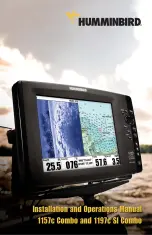
NAVMAN
FISH 4100 Installation and Operation Manual
8
Changing the Gain Mode
Gain (sensitivity) controls the amount of detail
displayed on the screen. The NAVMAN fishfinder has
two gain modes, Auto Gain and Manual Gain:
·
In Auto Gain, the gain is automatically adjusted
to compensate for water depth and clarity. The
use of Auto Gain is strongly recommended
when learning to use a fishfinder, or when
travelling at speed.
·
In Manual Gain, the user can adjust the gain to
compensate for water depth and clarity. Manual
settings range from 1 to 9. High settings may
amplify normal background noise until it
appears as random pixels on the screen. The
ideal setting produces only a small number of
random pixels. Normally the best results with a
fishfinder are obtained in Manual Gain but
practice and experience are required to
understand how to adjust the gain correctly.
To change between Auto Gain and Manual Gain, hold
+
or
-
. The Gain mode will be displayed briefly at
the bottom of the screen.
When in Manual Gain the gain symbol
is shown
at the top of the display, followed by the gain level.
Press
+
to increase the gain level or press
-
to
decrease the gain level.
Fish Arches
In ideal conditions and with Fish Symbols turned OFF,
a fish passing through the cone-shaped ultrasonic pulse
is displayed on the screen as a fish arch:
As the fish enters the weak edge of the sonar cone it
generates a weak return signal that turns on the first
pixel on the fishfinder screen. As the boat moves closer
to the fish the distance between the transducer and
the fish reduces and the return signal is displayed at
progressively shallower depths, producing the start
of an arch. When the fish is directly beneath the
transducer and in the middle of the beam then the
Fish detection and display
The fish symbol option can be customized, or switched
off altogether so that the echoes are not converted to
fish symbols on the screen. Section 4-4 explains how
to do this. The differences between Fish symbol on
and off are:
Fish Symbol ON
Using NAVMAN’s SBN sonar technology
the fishfinder analyses all return signals
and eliminates most false signals and
clutter so that remaining targets are most
likely fish. Depending on the strength of the
remaining signals, they are displayed as
either small, medium or large fish symbols
- with or without depth. Whilst the SBN
processing is very sophisticated it is not
foolproof and there will be times when the
unit will not be able to differentiate between
large air bubbles, rubbish containing air,
fishing floats etc. and genuine fish returns.
Fish Symbol OFF
For experienced users this will always
provide the best information as every sonar
return signal is displayed, whether it is
surface clutter, a thermocline or a fish.
returned signal is even stronger so the arch becomes
thicker. As the fish passes out of the cone the reverse
happens with a progressively weaker and deeper
return.
In reality there are many reasons why fish arches
can’t be seen. For example:
·
Poor transducer installation - please refer to
the Transducer Installation Guide.
·
If the boat is anchored then fish will tend to
show on the display as horizontal lines as they
swim into and out of the transducer sonar
beam. Slow speeds in deeper water give best
fish arch returns.
·
Range is important. It will be much easier to
see fish arches when using NAVMAN’s split
screen zoom mode to concentrate on a
particular section of water rather than just
displaying everything from the surface to the
bottom. Zooming increases screen resolution
and is necessary for good fish arches.
·
It is almost impossible to get fish arches in
shallow water as the transducer sonar beam is
very narrow near the surface and fish do not
stay within the beam long enough to display an
arch. Several fish in shallow water tend to
display as randomly stacked blocks of pixels.
3-3 HISTORY screen interpretation

























